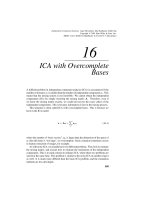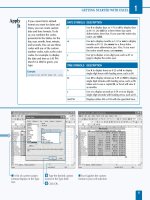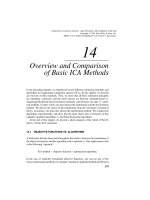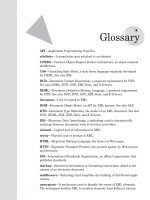Tài liệu Independent component analysis P11 ppt
Bạn đang xem bản rút gọn của tài liệu. Xem và tải ngay bản đầy đủ của tài liệu tại đây (183.35 KB, 9 trang )
11
ICA by Tensorial Methods
One approach for estimation of independent component analysis (ICA) consists of
using higher-order cumulant tensor. Tensors can be considered as generalization
of matrices, or linear operators. Cumulant tensors are then generalizations of the
covariance matrix. The covariance matrix is the second-order cumulant tensor, and
the fourth order tensor is defined by the fourth-order cumulants cum .
For an introduction to cumulants, see Section 2.7.
As explained in Chapter 6, we can use the eigenvalue decomposition of the
covariance matrix to whiten the data. This means that we transform the data so that
second-order correlations are zero. As a generalization of this principle, we can use
the fourth-order cumulant tensor to make the fourth-order cumulants zero, or at least
as small as possible. This kind of (approximative) higher-order decorrelation gives
one class of methods for ICA estimation.
11.1 DEFINITION OF CUMULANT TENSOR
We shall here consider only the fourth-order cumulant tensor, which we call for sim-
plicity the cumulant tensor. The cumulant tensor is a four-dimensional array whose
entries are given by the fourth-order cross-cumulants of the data: cum ,
where the indices are from to . This can be considered as a “four-
dimensional matrix”, since it has four different indices instead of the usual two. For
a definition of cross-cumulants, see Eq. (2.106).
In fact, all fourth-order cumulants of linear combinations of can be obtained
as linear combinations of the cumulants of . This can be seen using the additive
229
Independent Component Analysis. Aapo Hyv
¨
arinen, Juha Karhunen, Erkki Oja
Copyright
2001 John Wiley & Sons, Inc.
ISBNs: 0-471-40540-X (Hardback); 0-471-22131-7 (Electronic)
230
ICA BY TENSORIAL METHODS
properties of the cumulants as discussed in Section 2.7. The kurtosis of a linear
combination is given by
kurt
cum
cum (11.1)
Thus the (fourth-order)cumulants contain all the fourth-orderinformationof the data,
just as the covariance matrix gives all the second-order information on the data. Note
that if the are independent, all the cumulants with at least two different indices are
zero, and therefore we have the formula that was already widely used in Chapter 8:
kurt kurt .
The cumulant tensor is a linear operator defined by the fourth-order cumulants
cum . This is analogous to the case of the covariance matrix with
elements cov , which defines a linear operator just as any matrix defines one.
In the case of the tensor we have a linear transformation in the space of matrices,
instead of the space of -dimensional vectors. The space of such matrices is a linear
space of dimension , so there is nothing extraordinary in defining the linear
transformation. The th element of the matrix given by the transformation, say
, is defined as
cum (11.2)
where are the elements in the matrix that is transformed.
11.2 TENSOR EIGENVALUES GIVE INDEPENDENT COMPONENTS
As any symmetric linear operator, the cumulant tensor has an eigenvalue decom-
position (EVD). An eigenmatrix of the tensor is, by definition, a matrix such
that
(11.3)
i.e., ,where is a scalar eigenvalue.
The cumulant tensor is a symmetric linear operator, since in the expression
cum , the order of the variables makes no difference. Therefore, the
tensor has an eigenvalue decomposition.
Let us consider the case where the data follows the ICA model, with whitened
data:
(11.4)
where we denote the whitened mixing matrix by . This is because it is orthogonal,
and thus it is the transpose of the separating matrix for whitened data.
TENSOR EIGENVALUES GIVE INDEPENDENT COMPONENTS
231
The cumulant tensor of has a special structure that can be seen in the eigenvalue
decomposition. In fact, every matrix of the form
(11.5)
for
is an eigenmatrix. The vector is here one of the rows of the
matrix , and thus one of the columns of the whitened mixing matrix .Tosee
this, we calculate by the linearity properties of cumulants
cum
cum
cum (11.6)
Now, due to the independence of the , only those cumulants where
are nonzero. Thus we have
kurt (11.7)
Due to the orthogonality of the rows of ,wehave ,and
similarly for index . Thus we can take the sum first with respect to , and then with
respect to , which gives
kurt
kurt kurt (11.8)
This proves that matrices of the form in (11.5) are eigenmatrices of the tensor. The
corresponding eigenvalues are given by the kurtoses of the independent components.
Moreover, it can be proven that all other eigenvalues of the tensor are zero.
Thus we see that if we knew the eigenmatrices of the cumulant tensor, we could
easily obtain the independent components. If the eigenvalues of the tensor, i.e., the
kurtoses of the independent components, are distinct, every eigenmatrix corresponds
to a nonzero eigenvalue of the form , giving one of the columns of the
whitened mixing matrix.
If the eigenvalues are not distinct, the situation is more problematic: The eigenma-
trices are no longer uniquely defined, since any linear combinations of the matrices
corresponding to the same eigenvalue are eigenmatrices of the tensor as
well. Thus, every -fold eigenvalue corresponds to matrices that
are different linear combinations of the matrices corresponding to the
ICs whose indices are denoted by . The matrices can be thus expressed as:
(11.9)
232
ICA BY TENSORIAL METHODS
Now, vectors that can be used to construct the matrix in this way can be computed
by the eigenvalue decomposition of the matrix: The are the (dominant) eigen-
vectors of .
Thus, after finding the eigenmatrices of the cumulant tensor, we can decom-
pose them by ordinary EVD, and the eigenvectors give the columns of the mixing
matrix . Of course, it could turn out that the eigenvalues in this latter EVD are
equal as well, in which case we have to figure out something else. In the algorithms
given below, this problem will be solved in different ways.
This result leaves the problem of how to compute the eigenvalue decomposition
of the tensor in practice. This will be treated in the next section.
11.3 COMPUTING THE TENSOR DECOMPOSITION BY A POWER
METHOD
In principle, using tensorial methods is simple. One could take any method for
computing the EVD of a symmetric matrix, and apply it on the cumulant tensor.
To do this, we must first consider the tensor as a matrix in the space of
matrices. Let be an index that goes though all the couples .Thenwe
can consider the elements of an matrix as a vector. This means that we
are simply vectorizing the matrices. Then the tensor can be considered as a
symmetric matrix with elements cum , where the indices
corresponds to , and similarly for and . Itisonthismatrixthatwe
could apply ordinary EVD algorithms, for example the well-known QR methods. The
special symmetricity properties of the tensor could be used to reduce the complexity.
Such algorithms are out of the scope of this book; see e.g. [62].
The problem with the algorithm in this category, however, is that the memory
requirements may be prohibitive, because often the coefficients of the fourth-order
tensor must be stored in memory, which requires units of memory. The
computational load also grows quite fast. Thus these algorithms cannot be used in
high-dimensional spaces. In addition, equal eigenvalues may give problems.
In the following we discuss a simple modification of the power method, that
circumvents the computational problems with the tensor EVD. In general, the power
method is a simple way of computing the eigenvector corresponding to the largest
eigenvalue of a matrix. This algorithm consists of multiplying the matrix with the
running estimate of the eigenvector, and taking the product as the new value of the
vector. The vector is then normalized to unit length, and the iteration is continued
until convergence. The vector then gives the desired eigenvector.
We can apply the power method quite simply to the case of the cumulant tensor.
Starting from a random matrix , we compute and take this as the new value
of . Then we normalize and go back to the iteration step. After convergence,
will be of the form . Computing its eigenvectors gives one or
more of the independent components. (In practice, though, the eigenvectors will
not be exactly of this form due to estimation errors.) To find several independent
TENSOR DECOMPOSITION BY A POWER METHOD
233
components, we could simply project the matrix after every step on the space of
matrices that are orthogonal to the previously found ones.
In fact, in the case of ICA, such an algorithm can be considerably simplified.
Since we know that the matrices are eigenmatrices of the cumulant tensor, we
can apply the power method inside that set of matrices only. After every
computation of the product with the tensor, we must then project the obtained matrix
back to the set of matrices of the form . A very simple way of doing this is to
multiply the new matrix by the old vector to obtain the new vector
(which will be normalized as necessary). This can be interpreted as another power
method, this time applied on the eigenmatrix to compute its eigenvectors. Since the
best way of approximating the matrix in the space of matrices of the form
is by using the dominant eigenvector, a single step of this ordinary power method
will at least take us closer to the dominant eigenvector, and thus to the optimal vector.
Thus we obtain an iteration of the form
(11.10)
or
cum (11.11)
In fact, this can be manipulated algebraically to give much simpler forms. We have
equivalently
cum cum
(11.12)
wherewedenoteby the estimate of an independent component. By
definition of the cumulants, we have
cum
(11.13)
We can constrain
to have unit variance, as usual. Moreover, we have .
Thus we have
(11.14)
where is normalized to unit norm after every iteration. To find several indepen-
dent components, we can actually just constrain the corresponding to different
independent components to be orthogonal, as is usual for whitened data.
Somewhat surprisingly, (11.14) is exactly the FastICA algorithm that was derived
as a fixed-point iteration for finding the maxima of the absolute value of kurtosis in
Chapter 8, see (8.20). We see that these two methods lead to the same algorithm.
234
ICA BY TENSORIAL METHODS
11.4 JOINT APPROXIMATE DIAGONALIZATION OF EIGENMATRICES
Joint approximate diagonalization of eigenmatrices (JADE) refers to one principle of
solving the problem of equal eigenvalues of the cumulant tensor. In this algorithm,
the tensor EVD is considered more as a preprocessing step.
Eigenvalue decomposition can be viewed as diagonalization. In our case, the de-
velopments in Section 11.2 can be rephrased as follows: The matrix diagonalizes
for any .Inotherwords, is diagonal. This is because the
matrix is of a linear combination of terms of the form , assuming that the
ICA model holds.
Thus, we could take a set of different matrices , and try to make
the matrices as diagonal as possible In practice, they cannot
be made
exactly diagonal because the model does not hold exactly, and there are sampling
errors.
The diagonality of a matrix can be measured, for example,
as the sum of the squares of off-diagonal elements: . Equivalently, since
an orthogonal matrix does not change the total sum of squares of a matrix,
minimization of the sum of squares of off-diagonal elements is equivalent to the
maximization of the sum of squares of diagonal elements. Thus, we could formulate
the following measure:
diag (11.15)
where diag means the sum of squares of the diagonal. Maximization of
is then one method of joint approximate diagonalization of the .
How do we choose the matrices ? A natural choice is to take the eigenmatrices
of the cumulant tensor. Thus we have a set of just matrices that give all the relevant
information on the cumulants, in the sense that they span the same subspace as the
cumulant tensor. This is the basic principle of the JADE algorithm.
Another benefit associated with this choice of the is that the joint diagonal-
ization criterion is then a function of the distributions of the and a clear
link can be made to methods of previous chapters. In fact, after quite complicated
algebraic manipulations, we can obtain
cum (11.16)
in other words, when we minimize we also minimize a sum of the squared
cross-cumulants of the . Thus, we can interpret the method as minimizing nonlinear
correlations.
JADE suffers from the same problems as all methods using an explicit tensor
EVD. Such algorithms cannot be used in high-dimensional spaces, which pose no
problem for the gradient or fixed-point algorithm of Chapters 8 and 9. In problems
of low dimensionality (small scale), however, JADE offers a competitive alternative.
WEIGHTED CORRELATION MATRIX APPROACH
235
11.5 WEIGHTED CORRELATION MATRIX APPROACH
A method closely related to JADE is given by the eigenvalue decomposition of the
weighted correlation matrix. For historical reasons, the basic method is simply called
fourth-order blind identification (FOBI).
11.5.1 The FOBI algorithm
Consider the matrix
(11.17)
Assuming that the data follows the whitened ICA model, we have
(11.18)
where we have used the orthogonality of , and denoted the separating matrix by
. Using the independence of the , we obtain (see exercices)
diag diag
(11.19)
Now we see that this is in fact the eigenvalue decomposition of . It consists of the
orthogonal separating matrix and the diagonal matrix whose entries depend on
the fourth-order moments of the . Thus, if the eigenvalue decomposition is unique,
which is the case if the diagonal matrix has distinct elements, we can simply compute
the decomposition on , and the separating matrix is obtained immediately.
FOBI is probably the simplest method for performing ICA. FOBI allows the com-
putation of the ICA estimates using standard methods of linear algebra on matrices
of reasonable complexity ( ). In fact, the computation of the eigenvalue de-
composition of the matrix is of the same complexity as whitening the data. Thus,
this method is computationally very efficient: It is probably the most efficient ICA
method that exists.
However, FOBI works only under the restriction that the kurtoses of the ICs
are all different. (If only some of the ICs have identical kurtoses, those that have
distinct kurtoses can still be estimated). This restricts the applicability of the method
considerably. In many cases, the ICs have identical distributions, and this method
fails completely.
11.5.2 From FOBI to JADE
Now we show how we can generalize FOBI to get rid of its limitations, which actually
leads us to JADE.
First, note that for whitened data, the definition of the cumulant can be written as
tr (11.20)
236
ICA BY TENSORIAL METHODS
which is left as an exercice. Thus, we could alternatively define the weighted
correlation matrix using the tensor as
(11.21)
because we have
(11.22)
and the identity matrix does not change the EVD in any significant way.
Thus we could take some matrix and use the matrix in FOBI instead
of . This matrix would have as its eigenvalues some linear combinations of the
cumulants of the ICs. If we are lucky, these linear combinations could be distinct,
and FOBI works. But the more powerful way to utilize this general definition is to
take several matrices and jointly (approximately) diagonalize them. But this
is what JADE is doing, for its particular set of matrices! Thus we see how JADE is a
generalization of FOBI.
11.6 CONCLUDING REMARKS AND REFERENCES
An approach to ICA estimation that is rather different from those in the previous
chapters is given by tensorial methods. The fourth-order cumulants of mixtures give
all the fourth-order information inherent in the data. They can be used to define
a tensor, which is a generalization of the covariance matrix. Then we can apply
eigenvalue decomposition on this matrix. The eigenvectors more or less directly give
the mixing matrix for whitened data. One simple way of computing the eigenvalue
decomposition is to use the power method that turns out to be the same as the FastICA
algorithm with the cubic nonlinearity. Joint approximate diagonalization of eigen-
matrices (JADE) is another method in this category that has been successfully used in
low-dimensional problems. In the special case of distinct kurtoses, a computationally
very simple method (FOBI) can be devised.
The tensor methods were probably the first class of algorithms that performed
ICA successfully. The simple FOBI algorithm was introduced in [61], and the tensor
structure was first treated in [62, 94]. The most popular algorithm in this category
is probably the JADE algorithm as proposed in [72]. The power method given
by FastICA, another popular algorithm, is not usually interpreted from the tensor
viewpoint, as we have seen in preceding chapters. For an alternative form of the
power method, see [262]. A related method was introduced in [306]. An in-depth
overview of the tensorial method is given in [261]; see also [94]. An accessible
and fundamental paper is [68] that also introduces sophisticated modifications of the
methods. In [473], a kind of a variant of the cumulant tensor approach was proposed
by evaluating the second derivative of the characteristic function at arbitrary points.
The tensor methods, however, have become less popular recently. This is because
methods that use the whole EVD (like JADE) are restricted, for computational rea-
sons, to small dimensions. Moreover, they have statistical properties inferior to those
PROBLEMS
237
methods using nonpolynomial cumulants or likelihood. With low-dimensional data,
however, they can offer an interesting alternative, and the power method that boils
down to FastICA can be used in higher dimensions as well.
Problems
11.1 Prove that diagonalizes as claimed in Section 11.4.
11.2 Prove (11.19)
11.3 Prove (11.20).
Computer assignments
11.1 Compute the eigenvalue decomposition of random fourth-order tensors of size
and . Compare the computing times. What about a tensor
of size
?
11.2 Generate 2-D data according to the ICA model. First, with ICs of different
distributions, and second, with identical distributions. Whiten the data, and perform
the FOBI algorithm in Section 11.5. Compare the two cases.









